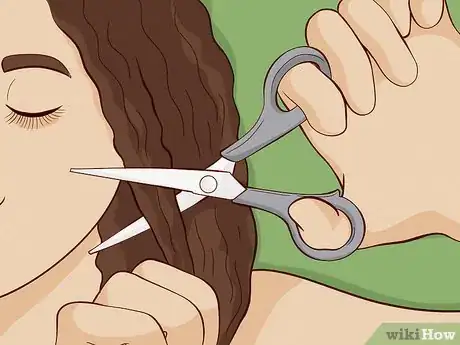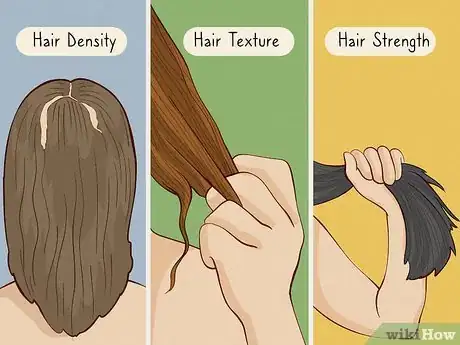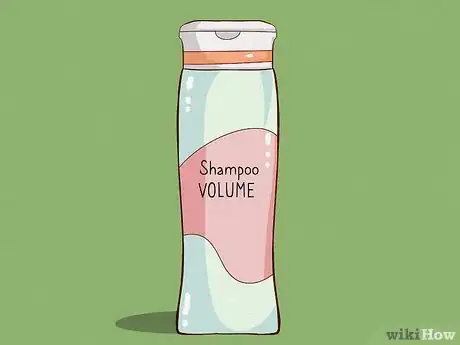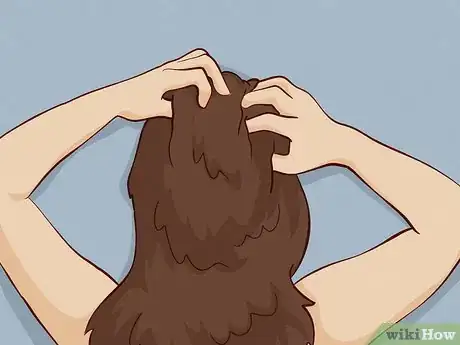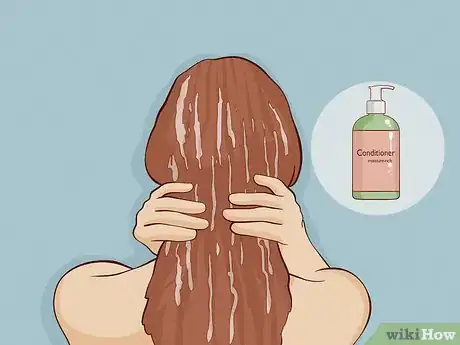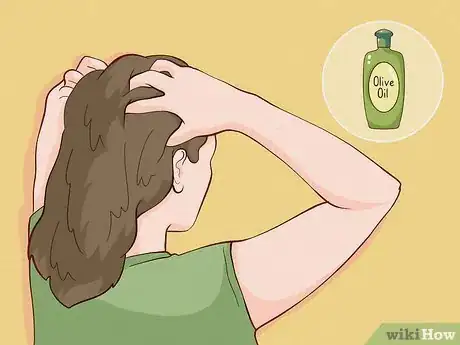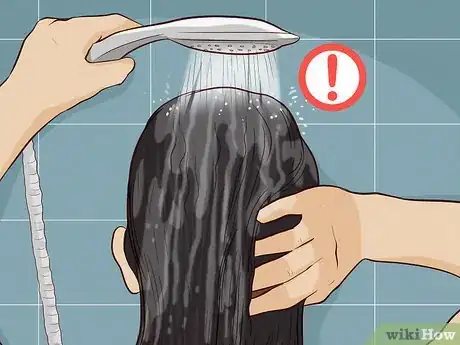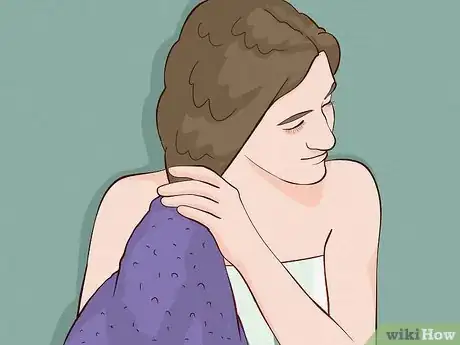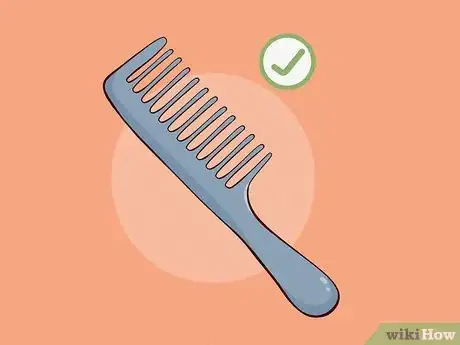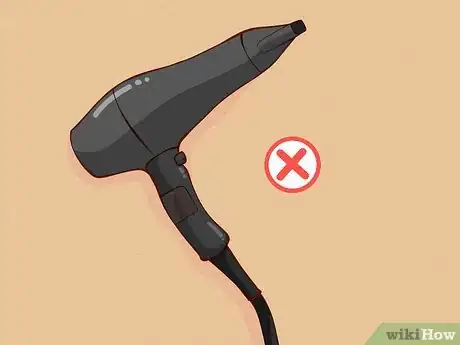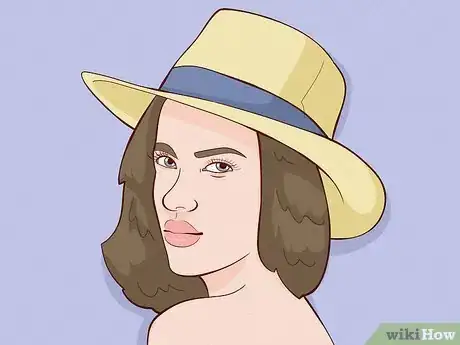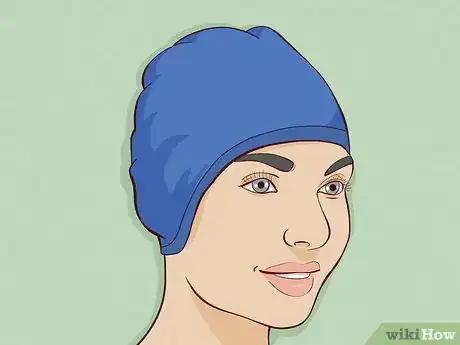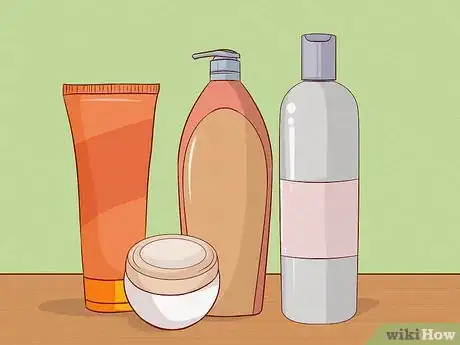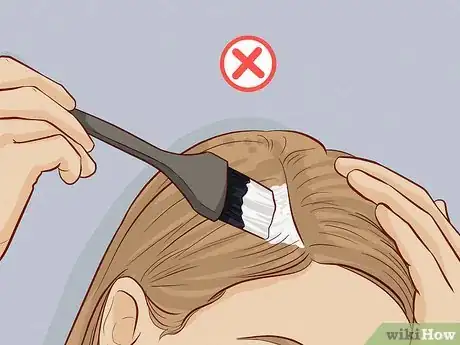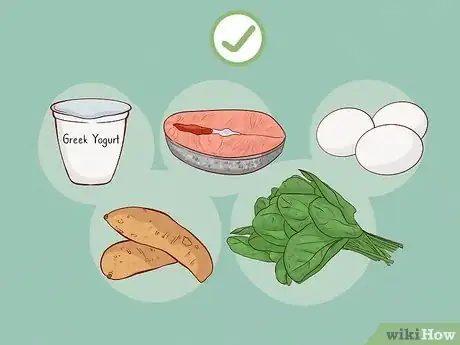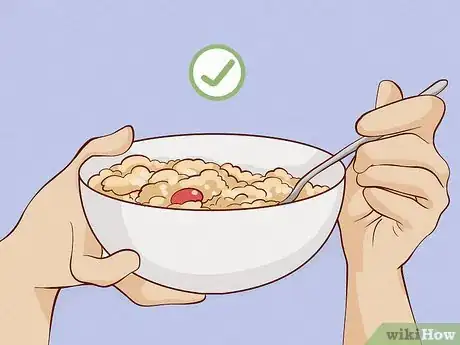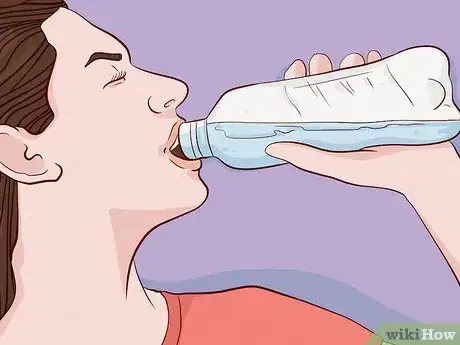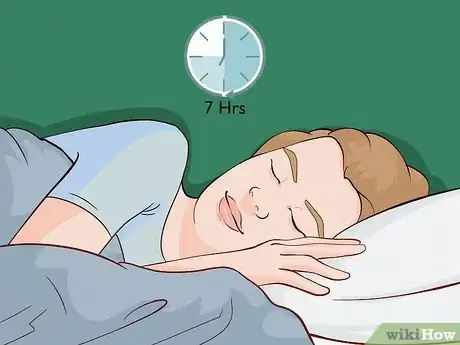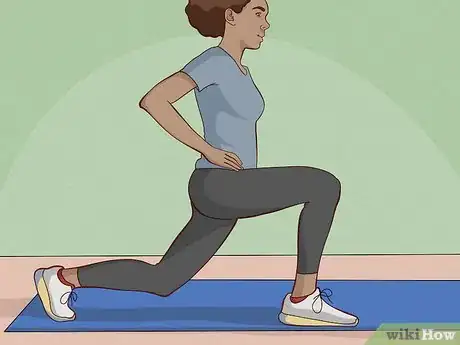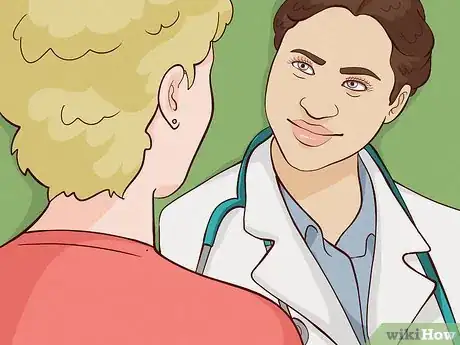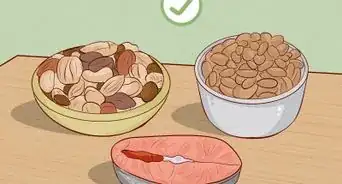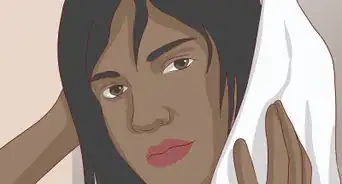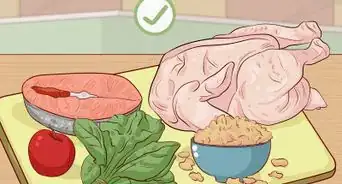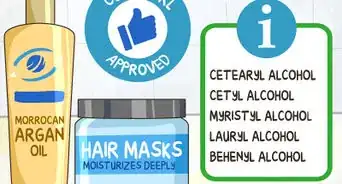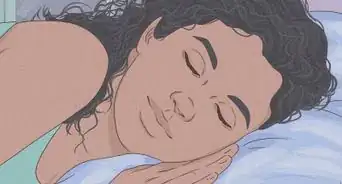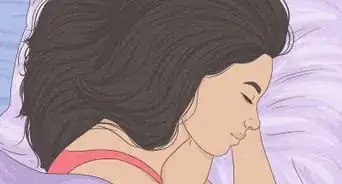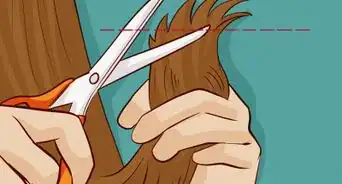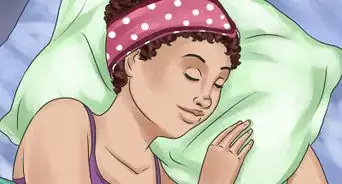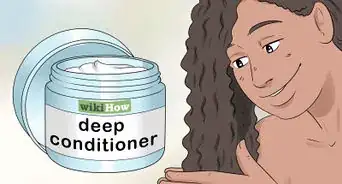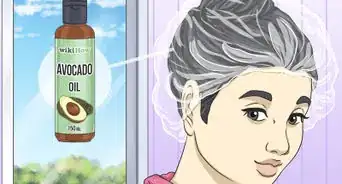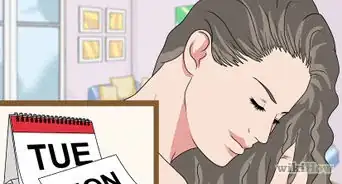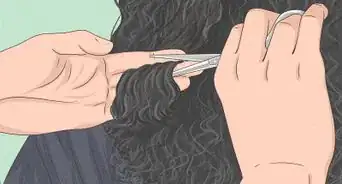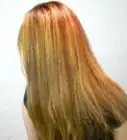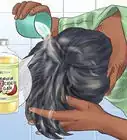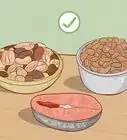This article was co-authored by Christine George. Christine George is a Master Hairstylist, Colorist, and Owner of Luxe Parlour, a premier boutique salon based in the Los Angeles, California area. Christine has over 23 years of hair styling and coloring experience. She specializes in customized haircuts, premium color services, balayage expertise, classic highlights, and color correction. She received her cosmetology degree from the Newberry School of Beauty.
There are 23 references cited in this article, which can be found at the bottom of the page.
wikiHow marks an article as reader-approved once it receives enough positive feedback. In this case, 90% of readers who voted found the article helpful, earning it our reader-approved status.
This article has been viewed 637,929 times.
Achieving healthy, strong hair takes dedication. By eating hair-strengthening foods, avoiding damaging grooming practices, and pampering your tresses with high-quality shampoos and conditioners, you can revitalize your hair. But before you freak out, realize that it is a natural part of the hair growth cycle to lose as many as 100-150 strands each day.[1]
Steps
Pampering Your Hair
-
1
-
2Know your hair type. When you know what type of hair you have, you are better able to keep it healthy by meeting its needs. You can discover your hair type by gauging its density, texture, and strength.[6]
- Density: Look at a patch of hair on the top of your head. If you can barely see your scalp through your hair, you have thick-density hair; if the hair is more spaced out, it’s of a fine density; and if it’s somewhere in the middle, your hair is of a medium density.[7] Also, the thinner your part line, the higher the density.
- Texture: Observe an individual strand of your hair. How thick or thin is the strand in relation to the hair of other people you know? You can also gauge how thick or fine your hair is by tugging on it — thick-textured hair will be stronger/less likely to break than fine-textured hair.[8] Fine hair feels more flexible and can have difficulty holding volume while thicker hair tends to be stubborn and full.
- Strength: Hair strength is measured by porosity and elasticity. Wash and towel-dry your hair, then feel it: if your hair feels quite wet, it’s more damaged/porous; if it feels quite dry, it’s healthier/less porous. The farther you can stretch your hair without it breaking, the more elastic and healthy it is.[9]
Advertisement -
3Use a high-quality shampoo and conditioner designed for your hair type.[10] [11] If you have fine hair, you can use volumizing or thickening shampoos and conditioners; if you have thick or oily hair, you may want to use a deep-cleansing shampoo and a light conditioner.
- There are myriad products to choose from — just be sure to choose something that suits your hair. In general, salon brands are thought to be of a higher quality than drugstore brands.
- Look for sulfate-free shampoo since sulfates can damage your hair.[12]
-
4Massage your scalp regularly. Massaging your scalp increases the blood flow to your hair follicles, conditions the scalp, and helps relieve stress. This will not only help keep your hair healthy, it may even help reduce and/or reverse hair loss.[13]
- You can give yourself a gentle scalp massage while shampooing your hair.
-
5Deep condition your hair regularly. You can do this using a store-bought conditioner or a homemade one. If you do buy a deep conditioning treatment, opt for a salon brand, as drugstore brands will likely contain lower-quality ingredients.[14]
- How often you deep condition your hair will depend on how healthy it is: if your hair is very damaged, deep condition it once a week.
- Pay close attention to the instructions on the bottle. A protein-based conditioner, for instance, will strengthen your hair, but can make it brittle if left on too long.
-
6Make your own deep-conditioning hair treatments at home. If you can’t afford to buy expensive salon conditioning treatments, and you’d rather not use drugstore brands, you can pamper your hair at home with the following treatment:[15]
- Massage your scalp and the ends of your hair with some warm oil. Options for oil include coconut, olive, and sweet almond, among others.
- Which oil you use will depend on your hair type and personal preference.[16] Jojoba oil is a safe bet for all hair types.[17]
- Wrap a hot, damp towel around your head. This will help the oil penetrate your hair. Just make sure it’s not too hot![18]
- Apply a hair mask to your hair. The type of mask will depend on your hair type. For dry hair, apply a paste of 1 or 2 egg whites and honey to your hair; for greasy hair, apply a paste of aloe vera gel, amla powder, and water to your hair.[19]
Preventing Damage to Your Hair
-
1Avoid over-washing your hair. Washing your hair too often robs your hair and scalp of their natural oils and dry your hair out.[20] Washing your hair too vigorously can also cause damage, so be gentle.
- How often you wash your hair will depend on your individual hair. Some people find that they need to wash their hair every day or two to keep it from getting too oily; others are able to wash their hair once or twice a week.
- When washing your hair, be gentle: massage the shampoo into your roots and then let it move down through the rest of your hair — don’t rub it into your hair, as this can cause damage.[21]
-
2Be gentle with your hair when it’s wet. When your hair is wet it’s more fragile and prone to breakage. After washing your hair, dry it gently by wrapping it or squeezing it with a towel, rather than rubbing it vigorously with one.[22]
- Wait for your hair to dry a bit before brushing it; when you do brush it, use a wide-tooth comb.
-
3Don’t over-brush your hair. The popular advice of “100 strokes a day” is wrong. Brushing your hair too much can actually cause split ends and breakage.[23]
- You also need to be careful about what kind of brush you use. Wide-tooth combs are commonly recommended by stylists as the most gentle option.[24]
- Boar bristle brushes may be the exception to this rule since they are much easier on the hair and can help distribute your hair's natural oils as well.
-
4Avoid heat-styling your hair. This includes flat-ironing/straightening, blow-drying, and curling your hair. These things can make your hair look dull; with regular use over time, they can cause permanent damage.[25]
- If you must heat-style your hair, be sure to coat your hair in a protective spray or balm before applying heat.[26] Most hair types should only use the low or medium settings and be sure to only style each section once. If curling, roll the hair up and clip while it cools. You can also create curls with set setting techniques like rollers or pin curls.
-
5Avoid putting your hair in ponytails or braids. Doing this can cause your hair to break, particularly if you pull your hair too tightly while styling it. In more extreme cases, hair can even fall out: this is called traction alopecia.[27]
- If you do put your hair in a ponytail use clothe covered elastics and never rubber bands.
- Be especially careful about putting your hair into a ponytail or braid when it’s wet and more prone to damage.
- The same goes for extensions and weaves, which can pull on your hair. If you have discomfort or pain in your scalp, your hair is likely causing too much pressure on your roots.[28]
-
6Protect your hair against the elements. The sun’s UV rays can bleach your hair, causing it to become dry and brittle. You’re not much safer in the rain, which can deposit harmful chemicals into your hair.[29]
- To protect your hair in the sun, wear a hat or spritz it with a UV-protecting spray. Some leave-in conditioners also provide UV protection.
- To protect your hair in the rain, use an umbrella or a hat, or wear waterproof jacket with a hood.
-
7Protect your hair at the swimming pool. The chlorine in pools can irritate your skin and scalp, and make your hair dry and brittle.[30] Before you get in the water, get your hair damp, slather on a protective product, and cover it with a swimming cap.
-
8Avoid using too many hair products. Resist the urge to tame your damaged locks with a tonne of conditioning and frizz-reducing products, which can leave your hair looking weighed down and oily.
- When using hair products, less is more. Start small and add additional product as needed. A small dab of anti-frizz cream/gel is often enough to tame fly-aways without making your hair look oily.
-
9Don’t put harsh chemicals on your hair. Hair that has been dyed, permed, straightened and/or relaxed is more likely to be thin, dull, and prone to breakage.[33]
Making Healthy Choices
-
1Eat for strong hair. In general, a healthy diet consists of lots of fruits and vegetables, lean proteins, healthy fats, and the avoidance of processed foods. Here are some key foods to eat for healthy hair:[34]
- Fish such as salmon, sardines, and mackerel contain omega-3 fatty acids, which protect you from disease and help your body grow and maintain healthy, shiny hair.
- Greek yogurt contains protein and vitamin B5 (also known as pantothenic acid), which are both essential for healthy hair growth. If you don’t get enough protein in your diet, your hair growth stalls.[35]
- Dark leafy greens such as spinach and kale contain vitamin A, iron, beta carotene, folate, and vitamin C, which are all helpful in maintaining a healthy scalp and hair. Vitamin C in particular is hugely helpful in preventing breakage.
- Sweet potatoes and other orange fruits and vegetables such as carrots, pumpkins, cantaloupe, and mangoes contain the antioxidant beta carotene, which helps keep hair hydrated and shiny.
- Cinnamon and other spices boost your circulation, helping to deliver oxygen and nutrients to your hair follicles. Sprinkle blood-flow-boosting spices into your various meals and beverages.
- Eggs are a great source of protein, iron, and biotin — a B vitamin that helps with hair growth.
-
2Make sure you get enough iron. In addition to making you tired, unfocused, and depressed, an iron deficiency can cause hair loss.[36]
- If you think you might not be getting enough iron in your diet, try eating fortified cereal, grains, and pastas.
- You can also find iron in soybeans, lentils, shellfish, dark leafy greens, beef, and organ meats like liver.[37]
-
3Drink enough water. If you are dehydrated you are likely to have a drier scalp and dull, dry hair.[38] Aim to drink roughly half your body weight (in pounds) in ounces of water each day.
- Example: a 150-pound woman would drink at least 75 ounces of water each day — more if she were active or living in a hot climate (i.e. if she were sweating).
-
4Reduce stress. Stress can lead to hair loss.[39] To help reduce stress, work on exercising regularly, sleeping at least 7 hours each night (8.5 hours if you’re a teenager), and doing things that help you relax.
- Some things that may help you relax include meditation, socializing with people who make you feel good, taking baths, or taking up a fun hobby (e.g., book club, music, dance, recreational sports).
-
5Exercise. In addition to being good for you generally, workouts are also good for your hair. Exercise can help increase circulation, release protective sebum from the scalp, and sweating can help release dirt or any dead skin that might clog your follicles.
-
6See a doctor. If your hair is thinning or otherwise damaged, and there’s no obvious reason for it (i.e. you’re not bleaching your hair regularly or constantly frying it with heat styling tools), see a doctor to rule out any potential health problems. Some health problems that can lead to hair loss/damage:[40]
- Overactive or underactive thyroid
- Other hormonal problems
- Anemia/iron deficiency
- Exposure to harmful chemicals
- Severe infections
- Side effects of certain medications
Expert Q&A
Did you know you can get expert answers for this article?
Unlock expert answers by supporting wikiHow
-
QuestionHow can I get healthy hair at home?
 Christine GeorgeChristine George is a Master Hairstylist, Colorist, and Owner of Luxe Parlour, a premier boutique salon based in the Los Angeles, California area. Christine has over 23 years of hair styling and coloring experience. She specializes in customized haircuts, premium color services, balayage expertise, classic highlights, and color correction. She received her cosmetology degree from the Newberry School of Beauty.
Christine GeorgeChristine George is a Master Hairstylist, Colorist, and Owner of Luxe Parlour, a premier boutique salon based in the Los Angeles, California area. Christine has over 23 years of hair styling and coloring experience. She specializes in customized haircuts, premium color services, balayage expertise, classic highlights, and color correction. She received her cosmetology degree from the Newberry School of Beauty.
Master Hair Stylist & Colorist Avoid washing your hair every day and limit your use of heat styling products as much as possible. Use a hydrating shampoo and conditioner designed for your hair type, and be gentle when you're drying your hair. The fewer styling tools and damaging products you use in your hair, the healthier it will be in the long run.
Avoid washing your hair every day and limit your use of heat styling products as much as possible. Use a hydrating shampoo and conditioner designed for your hair type, and be gentle when you're drying your hair. The fewer styling tools and damaging products you use in your hair, the healthier it will be in the long run. -
QuestionHow can I make my hair grow stronger?
 Laura MartinLaura Martin is a Licensed Cosmetologist in Georgia. She has been a hair stylist since 2007 and a cosmetology teacher since 2013.
Laura MartinLaura Martin is a Licensed Cosmetologist in Georgia. She has been a hair stylist since 2007 and a cosmetology teacher since 2013.
Licensed Cosmetologist
-
QuestionHow do I make my hair thicker?
 Laura MartinLaura Martin is a Licensed Cosmetologist in Georgia. She has been a hair stylist since 2007 and a cosmetology teacher since 2013.
Laura MartinLaura Martin is a Licensed Cosmetologist in Georgia. She has been a hair stylist since 2007 and a cosmetology teacher since 2013.
Licensed Cosmetologist
Warnings
- Some people claim that you can strengthen your hair by pulling on it and twisting it. There is limited research available to suggest that twisting or tying up your hair will strengthen it by stimulating the arrector pili muscle.[41] Many specialists claim that consistently pulling on hair can lead to hair loss.[42]⧼thumbs_response⧽
References
- ↑ https://www.naturallycurly.com/curlreading/transitioning/hair-growth-cycle-myths-and-facts/
- ↑ http://www.webmd.com/beauty/hair-repair/8-ways-youre-damaging-your-hair?page=4
- ↑ http://www.closeronline.co.uk/2015/01/how-to-stop-split-ends
- ↑ http://www.cosmopolitan.com/style-beauty/beauty/how-to/a267/snip-split-ends/
- ↑ http://www.closeronline.co.uk/2015/01/how-to-stop-split-ends
- ↑ http://www.xovain.com/hair/hair-type-analysis
- ↑ http://www.xovain.com/hair/hair-type-analysis
- ↑ http://www.xovain.com/hair/hair-type-analysis
- ↑ http://www.xovain.com/hair/hair-type-analysis
- ↑ http://www.webmd.com/beauty/shampoo/hair-washing
- ↑ http://www.webmd.com/beauty/advances-skin-care-9/thinning-hair-shampoo
- ↑ Christine George. Master Hair Stylist & Colorist. Expert Interview. 10 January 2020.
- ↑ http://www.pacificcollege.edu/news/blog/2015/02/01/benefits-scalp-massage-hair-loss
- ↑ http://www.today.com/style/best-hair-masks-market-why-you-should-try-them-t9696
- ↑ https://www.thehealthsite.com/beauty/beauty-tip-9-pamper-your-tresses-with-a-hair-spa-at-home-171534/
- ↑ https://www.thehealthsite.com/beauty/beauty-tip-9-pamper-your-tresses-with-a-hair-spa-at-home-171534/
- ↑ http://www.thehealthsite.com/beauty/tips-to-oil-your-hair-the-right-way-by-hair-expert-jawed-habib/
- ↑ https://www.thehealthsite.com/beauty/beauty-tip-9-pamper-your-tresses-with-a-hair-spa-at-home-171534/
- ↑ https://www.thehealthsite.com/beauty/beauty-tip-9-pamper-your-tresses-with-a-hair-spa-at-home-171534/
- ↑ Christine George. Master Hair Stylist & Colorist. Expert Interview. 10 January 2020.
- ↑ http://www.webmd.com/beauty/hair-repair/8-ways-youre-damaging-your-hair?page=3
- ↑ https://www.aad.org/dermatology-a-to-z/health-and-beauty/hair-care/stop-hair-damage
- ↑ http://www.webmd.com/beauty/hair-repair/8-ways-youre-damaging-your-hair?page=3
- ↑ https://www.aad.org/dermatology-a-to-z/health-and-beauty/hair-care/stop-hair-damage
- ↑ Christine George. Master Hair Stylist & Colorist. Expert Interview. 10 January 2020.
- ↑ http://www.webmd.com/beauty/hair-repair/8-ways-youre-damaging-your-hair?page=4
- ↑ http://www.webmd.com/beauty/hair-repair/8-ways-youre-damaging-your-hair?page=3
- ↑ http://www.webmd.com/beauty/hair-repair/8-ways-youre-damaging-your-hair?page=3
- ↑ http://www.indiatimes.com/health/healthyliving/hair-care-20-ways-to-stronger-hair-236875-9.html
- ↑ http://news.health.com/2013/07/03/chlorine/
- ↑ http://news.health.com/2013/07/03/chlorine/
- ↑ http://news.health.com/2013/07/03/chlorine/
- ↑ http://www.webmd.com/beauty/hair-repair/8-ways-youre-damaging-your-hair?page=2
- ↑ http://www.webmd.com/beauty/hair-nails/ss/slideshow-foods-healthy-hair
- ↑ http://www.webmd.com/beauty/hair-nails/ss/slideshow-foods-healthy-hair
- ↑ http://www.indiatimes.com/health/healthyliving/hair-care-20-ways-to-stronger-hair-236875-3.html
- ↑ http://www.webmd.com/beauty/hair-nails/ss/slideshow-foods-healthy-hair
- ↑ http://www.webmd.com/diet/6-reasons-to-drink-water?page=2
- ↑ http://www.webmd.com/skin-problems-and-treatments/hair-loss/hair-problems?page=2
- ↑ http://www.webmd.com/skin-problems-and-treatments/hair-loss/hair-problems?page=2
- ↑ http://www.ncbi.nlm.nih.gov/pmc/articles/PMC4158628/
- ↑ http://www.webmd.com/skin-problems-and-treatments/hair-loss/tc/hair-loss-cause
About This Article
To get healthy, strong hair, massage your scalp while you shampoo to increase blood flow to your hair follicles. Additionally, deep condition your hair using a commercial product or Jojoba or coconut oil. When your hair is wet, squeeze it dry with a towel rather than rubbing it, since it's more fragile when it's wet. Also, avoid heat-styling your hair with dryers and flat irons, which can cause damage over time. Finally, eat a healthy diet, drink plenty of water, and exercise regularly if you can, since these lifestyle choices all impact your hair. For more from our Cosmetology reviewer on getting healthy, strong hair, including by getting regular trims, read on!
